Freiburg likes to pride itself for being an open, tolerant and green city. There is a side of Freiburg that many people do not see. Despite the living conditions of refugees, not just in Freiburg, but in the whole of Europe, being widely know. They are mainly kept out of sight of our everyday life. We should not accept them as normality. Here is protocol made by a member of a group that recently visited, with other members of the city council of Freiburg, some of their refugee camps. It is not a total view of the living conditions, but demonstrates again that these places can not be accepted.
On Friday the 7th of December a delegation from Freiburgs city council made a visit to three of the cities refugee camps. Those of Hammerschmied Straße (1) and St. Christoph (3) are in full control of the municipal authority of Freiburg, that of Bissierstraße (2) is controlled together with the federal State of Baden-Württemberg. (Numbers are for map below)
The reason for this visit was due to a recent paper brought forward by the administration to increase the charges that the camps residents have to pay. This is not classed as rent, due to other costs being mixed in, but even considering this, the fees being paid here are higher than would be expected for comparable accommodation.
Not all residents are required to pay, for example those who are barred from employment have their fees paid for by the local authority. However a lot of residents work and have to pay for their accommodation, which as will be shown, is a lot of money for dreadful living conditions.
For this reason the proposal, to increase charges, brought forward by the local authority has been postponed, but they have stated that they will bring it in again at the start of next year (2013).
Hammerschmied Straße
The first camp that we visited is the Hammerschmied Straße (built 1991, nr. 1 on the map bellow ).
It is immediately obvious that the buildings are in a bad state of disrepair.
There are around 200 residents, more than the half of the residents are bellow the age of 18. The camp itself is on the edge of the city – and is often the case with refugee camps - well outside of any residential areas. Bordered on one side by a sport club and on the other by a cemetery. Running directly beside the camp, only a couple of meters away, is a well used train line, and directly beside that a dual carriage way (see photo bellow). The city plans to change the status of this street to a motorway. In short there is a large amount of noise pollution.
The only area of the camp with some form of protection against the noise is the courtyard. Residents are instructed to sleep on the side of the houses away from the road to avoid the detrimental health effects from noise (http://en.wikipedia.org/wiki/Health_effects_from_noise).
A motion proposed in 2009 for some form of action to be taken to reduce noise pollution, was answered as follows.
“Soundproof windows will currently not be installed, due to the low level of sound-absorbing capacity of the buildings walls. An effective protection against noise pollution can only be achieved with an improvement in the exterior walls.”
Council Paper G-09/185
This demonstrates that the situation of the camp as well as the condition of the barracks has been known for some time. Yet nothing has been done to change this situation.
First of all we were shown the administrative rooms of the social workers. They share a kitchen with the residents. The laundry room for the whole camp is in this part of the house as well and can only be used when the social workers are present (no use at week ends or on public holidays).
It goes without saying that the amount of room here is very small, and that the living conditions are cramped.
We were then shown to a common room, where school pupils can do their homework or get access to a computer. This room is a container, which can not be used in winter due to the heating being insufficient. The floor is breaking apart and needs to be repaired. New floor boards are available. The next problem is that the roof lets in water and that if the floor gets repaired then it will immediately get water damage, which will then be made worse by winter temperatures. To put it short, the room is unusable.
The next room which we were shown is on the 1st floor of one of the barrack building and is a place where the younger children can meet.
Here one of the children that lives in the home turned up with a small petition that he collected. The petition was about the chip-cards that are in use for the majority of the refugees in Freiburg. They are special plastics cards which are given to the refugees instead of money. They can only be used in certain shops and some goods are blocked and can not be purchased.
The example that the young residents gave was that he wants to play football at school and wants to buy football boots. There are only two shops where they can purchase clothes of any kind. Both of these shops are very expensive and have no shoes that they can afford, other shops have shoes that are affordable, but in theses shops the cards won't work. The example here is football boots, but the same applies for all clothing and for many other items as well.
The chip-cards do result in another restriction of basic freedoms and they are also impracticable for all those involved, not just the use by the residents, but also the administration of them. The end result has to be seen that they are a method of stigmatising and controlling, because there is no practical reason why the administration would use this method.
While we were being shown to another part of the camp, one of the residents took a couple of us into the part of the barrack where their family is living.
Both of the parents work, therefore they pay fees for the housing. This payment is higher than the rent table (Mietspiegel), which is the list of rent paid for comparable housing. Here we were shown that when holes, leaks or mould are found in the house that these are treated by covering them with paper and then sometimes painting over it again. This shows that this is mainly due to the buildings being in disastrous condition with insufficient funds to carry out repairs. This was mainly the case in the shower room. But it is also the case in the kitchen where water often comes in through the ceiling. (both photos bellow)
The family have lived in these conditions for over 7 years. They would be able to pay for accommodation, but can not get a flat outside of the camp. This is mainly due to the fact that although they do work, they are still a low income household. The housing that they could afford is mainly council housing, but the city prevents refugees from moving into council housing. This is despite the city loosing a court case to another resident. The court ruled that the city has to allow the residents access to council housing. Instead of accepting this ruling, the city is appealing against this decision. Which can only be seen as an attempt to keep theses people in the camps.
The next barrack that we were shown, has considerable structural damage. Despite the structural damage there were no warning signs, in the upper rooms it is unsafe to walk on certain parts of the floor. The residents on the upper floor have been moved out, but in the lower levels there are still people living there.
Bissierstraße
Built in the year 1989, Nr. 2 on the Map bellow. The first news that we got from the social workers at the camp was that repairs, that they had reported for months, and had often complained about, had been carried out the day before the visit.
The conditions of the buildings could not be hidden though. The building themselves are very run down.
We were shown a kitchen, that had not been used for some months, due to mould. The workers the day before done enough that the kitchen was now declared safe for use. There was however quite a lot of scepticism as to whether this was true. As can be seen from the photo (bellow), the condition of the kitchen is still appalling. In the kitchen directly above plastic has also been put on the wall correlating to the damage in the kitchen bellow. It would have to be presumed that the damage does not stop with the ceiling but the mould and the damp also effect those living on the other side of the ceiling.
In another kitchen, a small hole can be seen in the ceiling directly above the cooker (marked with a red circle bellow). This hole leads to a shower room. Cooking and showering times have to be coordinated. During showering above a pot has to be put on the cooker bellow to collect water and at these times it is not possible to use the cooker. The Shower is still in use, in this case by 16 residents.
The shower room itself (photo bellow) is missing the ceiling above the shower itself and has obvious signs of mould. Instead of rectifying the problems here the city and the federal state apparently argue about who is responsible for the actual building the local city or the regional government in Stuttgart. While they argue, people have to continue living in these conditions.
We were also shown other areas of this camp, such as a common room for kids. In general the building are falling apart and have a large level of mould, which is obviously detrimental to health. What is obvious was also that the residents do try to keep the areas as clean as possible, but it is impossible when the mould is completely through the fabric of the buildings.
What is also unfortunately worth noting here is that we also met a 17 year old resident that has spent 17 years in the cities refugee camps.
St. Christoph
Built in the year 1991, Nr. 3 on the map. As is the case with most of camps in Freiburg it is mainly lived in by families that identify themselves as, or are identified as Roma. These families have mainly been displaced either directly by the Kosovo war (1998-99), or the movements resulting from this. It also has to be said that many of the children living here are also born in Freiburg and even for many of the youths and young adults Freiburg is the only home that they know. This is Important when considering what the effects of an deportation.
What often gets forgotten though, is the effect that a deportation would have on the older refugees, many of whom have had traumatic experience and would suffer by being deported to these places.
The camp is in a industrial park, which means much of the infrastructure for daily life is missing (shops, schools etc.). For a couple of years this camp received some attention when the “office for living room supply” (Amt für Wohnraumversorgung) put a family of 6 persons into a container room of 12 square meters.
This was the first attempt where the city tried to place people in containers and try to stop them from getting normal housing. Since then the city has given out over 1 million Euros in buying new containers. The comparison, on the photo bellow, between the two can be seen. The barracks here are comparable with the run-down conditions in the other camps.
The new containers are definitely an improvement on the current living conditions in the barracks. One worrying aspect here is the claim from the office director of the “office for living room supply” that the containers will be a good investment and that they will have a long use expectancy of around 50 years. The mayor as well as members of ruling groups in the council were very adamant that photographs also be made of the new accommodation, to balance out the picture of refugee accommodation. We will at least be able to compare what theses containers look like if/when they are still being used in 50 years. The barracks were also new in 1991, and we can see now in what kind of condition they are in.
Future of refugee camps in Freiburg
Instead of seeing the problems here as being endemic to the situation of refugees. The city administration has decided to boldly carry on with their refugee camp policy.
They have now decided to increase the financial resources for maintenance from 60,000 € to around 260,000 € a year. It has to be stated that this is for the all the camps and hostels for refugees and homeless persons. It may stop some further deterioration in the building conditions but even the city sees here that it is too little too late.
The other measure that the city is taking is that it has bought, on the second hand market, a 7 year old school building from Ingolstadt for 600,000 Euros. This is also a container construction and is to be transported to Freiburg and reassembled for families to live in.
As for the long term perspectives the camps themselves are to be “renewed”. Existing buildings are to be pulled down and built anew. The misery of those who are living here is to be perpetuated. Instead of trying to get these people in real housing millions of Euros will now be given out to maintain social and cultural segregation.
The refugee camps and the chip-cards can only be described as racist and inhuman. The measure being taken here are only meant to be temporary. However we can see here that for some they can last 17 years and there are many that are 13 or 14 years in this “temporary” situation. And there are no perspective of this changing in the near future.
Also the argument that the current housing market in Freiburg is very difficult, but as we can see that when people are living her for seven, 12 or 17 years that it is not a specific problem.
We are calling for an end to refugee camps. That real integration can only occur in real life situations and not when people are forced to live in squalid accommodation on the edge of the city. They are cut off not just geographically but economically socially and culturally from the rest of the City. New buildings will not change the fact that the camps themselves are racist and inhuman.
For an open city – free of xenophobia and racial hatred
source of article (External Link)

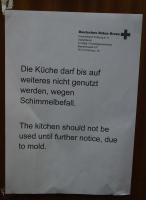
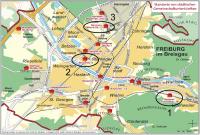
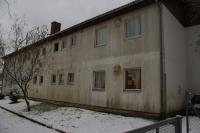
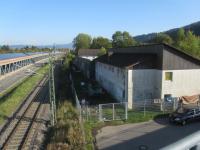
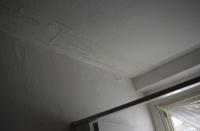
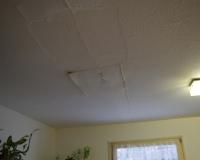
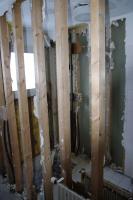
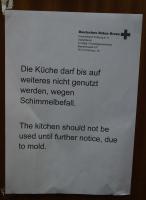
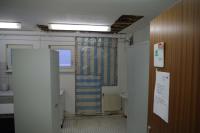
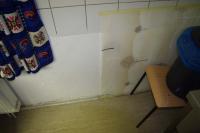
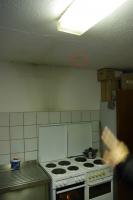
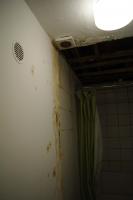
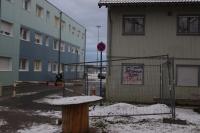
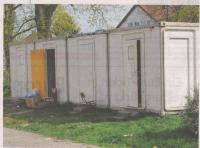
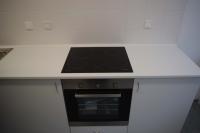
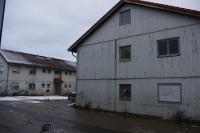
Massive Anwohnerproteste gegen Flüchtlingswohnheim
Massive Anwohnerproteste gegen Flüchtlingswohnheim